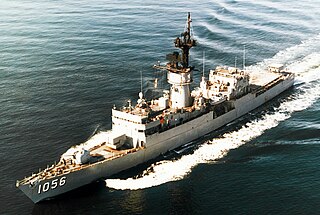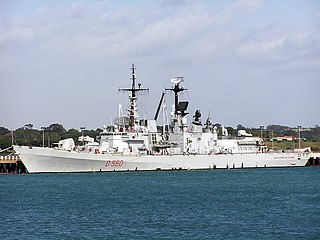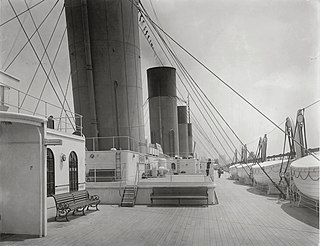
In naval architecture, a poop deck is a deck that forms the roof of a cabin built in the rear, or "aft", part of the superstructure of a ship.

The flight deck of an aircraft carrier is the surface from which its aircraft take off and land, essentially a miniature airfield at sea. On smaller naval ships which do not have aviation as a primary mission, the landing area for helicopters and other VTOL aircraft is also referred to as the flight deck. The official U.S. Navy term for these vessels is "air-capable ships".

The Baltimore-class cruiser was a large class of heavy cruisers in the United States Navy commissioned during and shortly after World War II. Fourteen Baltimores were completed, more than any other class of heavy cruiser, along with three ships of the Oregon City-sub-class. Fast and heavily armed, the Baltimore cruisers were mainly used in World War II to protect the fast aircraft carriers in battle groups from air attack. Additionally, their 8-inch (203 mm) main guns and secondary 5-inch (127 mm) guns were regularly used to bombard land targets in support of amphibious landings. After the war, only six Baltimores and two Oregon City-class ships remained in service, while the rest were moved to the reserve fleet. However, all ships except Boston, Canberra, Chicago and Fall River were reactivated for the Korean War. Except for St Paul, all the ships retaining all-gun configurations had very short service lives, and by 1971 were decommissioned, and started showing up in the scrap-sale lists. However, four Baltimore-class cruisers were refitted and converted into some of the first guided missile cruisers in the world, becoming two of the three Albany-class and two Boston-class cruisers. The last of these was decommissioned in 1980, with the Chicago lasting until 1991 in reserve. No example of the Baltimore class still exists.

A fishing trawler is a commercial fishing vessel designed to operate fishing trawls. Trawling is a method of fishing that involves actively dragging or pulling a trawl through the water behind one or more trawlers. Trawls are fishing nets that are pulled along the bottom of the sea or in midwater at a specified depth. A trawler may also operate two or more trawl nets simultaneously.

The La Fayette class are general purpose frigates built by DCNS and operated by the French Navy. Derivatives of the type are in service in Saudi Arabia, Singapore and Taiwan.
A lazarette is a special area on a boat. It is often an area near or aft of the cockpit. The word is similar to and probably derived from lazaretto. A lazarette is usually a storage locker used for gear or equipment a sailor or boatswain would use around the decks on a sailing vessel.

The California class of cruisers were a set of two nuclear-powered guided missile cruisers operated by the United States Navy between 1974 and 1998. Other than their nuclear power supply and lack of helicopter hangars, ships of the California class were comparable to other guided missile cruisers of their era, such as the Belknap class. The class was built as a follow-up to the nuclear-powered Long Beach, Bainbridge, and Truxtun classes. Like all of the nuclear cruisers, which could steam for years between refuelings, the California class was designed in part to provide high endurance escort for the navy's nuclear aircraft carriers, which were often limited in range due to their conventionally powered escorts continuously needing to be refueled.

USS Miller (FF-1091), originally (DE-1091) was a Knox-class destroyer escort in the United States Navy. She was named for Cook Third Class Doris "Dorie" Miller, who was awarded the Navy Cross for his actions at the attack on Pearl Harbor.

The Royal Saudi Arabian Navy, sometimes referred to as the Royal Saudi Naval Forces (RSNF), is the naval force of the Kingdom of Saudi Arabia. The Navy has more than 13,500 officers and men, including Marines. The Naval headquarters is in Riyadh. The Western Fleet is based in the Red Sea with the main base at Jeddah. The Eastern Fleet is based in the Persian Gulf with headquarters at Jubail. Other naval facilities were located at Yanbu, Dammam, and Ras Mishab.

The Haruna-class destroyer was a destroyer class built for the Japan Maritime Self-Defense Force (JMSDF) in the early 1970s. These helicopter carrying destroyers (DDH) are built around a large central hangar which houses up to three helicopters.

USS Connole (FF-1056) was a Knox-class frigate. Named for Commander David R. Connole, Captain of USS Trigger when the submarine was lost in battle in March 1945.

USS Cook (FF-1083) was a Knox-class frigate built for the United States Navy by Avondale Shipyard, Bridge City, Louisiana.

USS Donald B. Beary (FF-1085) was a Knox-class frigate built for the United States Navy

The Audace-class destroyers were two guided missile destroyers built for the Italian Navy during the Cold War. An improvement of the Impavido class, these ships were designed for area air defence and also had a heavy gun armament. They were fitted with contemporary American radars and sonars, but also, as the next Italian ships, all the modern weapons made by Italian industry of the time, such torpedoes, helicopters and guns. Also some indigenous radars were fitted.

The Durand de la Penne class are two guided missile destroyers operated by the Italian Navy. The design is an enlarged version of the Audace class, updated with diesel and gas turbine CODOG machinery and modern sensors. Four ships were planned but the second pair were cancelled when Italy joined the Horizon project.
The Stenka class is the NATO reporting name for a class of patrol boats built for the Soviet Navy and Soviet Allies. The Soviet designation was Project 205P Tarantul. The boats are an anti-submarine (ASW) patrol boat version of the Osa-class missile boat.
In naval architecture, a taffrail is the handrail around the open deck area toward the stern of a ship or boat. The rear deck of a ship is often called the afterdeck or poop deck. Not all ships have an afterdeck or poop deck. Sometimes taffrail refers to just curved wooden top of the stern of a sailing man-of-war or East Indiaman ship. The rail of these wooden sailing ships usually had hand-carved wooden rails, often highly decorated. Sometimes taffrail refers to complete deck area at the stern of a vessel.

































